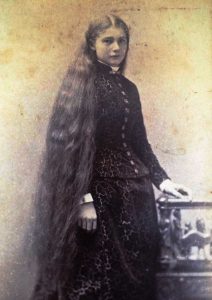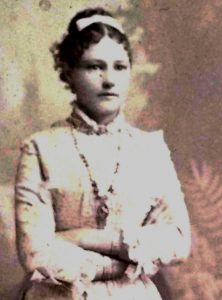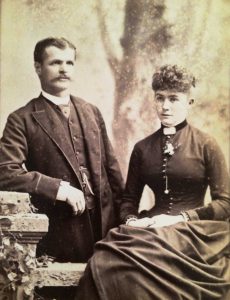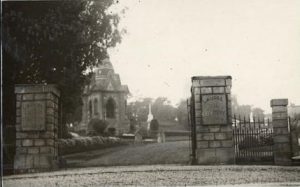
We all have them. Yes, images of individuals from long ago staring back at us as we work our way through the branches of our family tree. I don’t know about you, but I often hope I might compel my research right past their telling faces; after all “they” are just another set of vital records to record – right? However it rarely works that way for any of us – if it did, we’d probably drop our genealogical oaths and get back to some solid and familiar stamp collecting. No, in our usual practice of gathering up any one of those timeless faces, we find faces that somehow look back “to” us, asking us to have their stories told.
This happened to me last spring while researching the life of my great-great-great-great-uncle, Samuel Norton Sprague.[1] It was through “Uncle Sam” that I encountered Miss Carrie Dexter, his step-daughter. I admit it – I was immediately drawn to her, wondering who this beautiful young lady was from long ago. What was her story? What was it she might want me to know – if she could tell?
 Born into a fairly prosperous Rhode Island family in 1863,[2] Carrie, along with her parents Obadiah and Caroline Dexter, sailed around the Cape west to Northern California.[3] In 1871, Dr. Dexter passed away, leaving Mrs. Dexter, Carrie, and her siblings to travel northward into California’s Gold Country.[4] Here Carrie’s mother met and married my uncle, Samuel Norton Sprague.[5] Life could not have been easy for Carrie and her mother. As near as I can surmise, my “Uncle Sam” was a bit of ne’er do well and no doubt very difficult to live with. (Uncle Sam was always moving onto his next big opportunity, one which never ‘panned’ out, i.e. life in the Gold Country…). Perhaps because of this, Carrie, only thirteen years old at the time, and her age “mis-stated” as “16,” married her first husband, Cornelius Jacob Paul, a 27-year-old seaman from The Netherlands.[6] Carrie married Mr. Paul barely six months after her widowed mother had married Mr. Sprague.[7]
Born into a fairly prosperous Rhode Island family in 1863,[2] Carrie, along with her parents Obadiah and Caroline Dexter, sailed around the Cape west to Northern California.[3] In 1871, Dr. Dexter passed away, leaving Mrs. Dexter, Carrie, and her siblings to travel northward into California’s Gold Country.[4] Here Carrie’s mother met and married my uncle, Samuel Norton Sprague.[5] Life could not have been easy for Carrie and her mother. As near as I can surmise, my “Uncle Sam” was a bit of ne’er do well and no doubt very difficult to live with. (Uncle Sam was always moving onto his next big opportunity, one which never ‘panned’ out, i.e. life in the Gold Country…). Perhaps because of this, Carrie, only thirteen years old at the time, and her age “mis-stated” as “16,” married her first husband, Cornelius Jacob Paul, a 27-year-old seaman from The Netherlands.[6] Carrie married Mr. Paul barely six months after her widowed mother had married Mr. Sprague.[7]

While my twenty-first century mind can’t accept the reasons for such a young marriage, it’s likely that Carrie’s mother, the new Mrs. Sam Sprague, needed to get Carrie out of the house and away from my testy Uncle Sam. The newlyweds, Carrie and Cornelius Paul, made their home in San Francisco. I like to think that Carrie and Cornelius were comforted by the births of their two children, though later events leave Carrie’s life and a sense of her happiness murky at best.[8] Whatever was happening in the household of Carrie and Cornelius, the marriage didn’t last. By 1888, it is possible that Carrie may have become pregnant again, and perhaps not with the sea-faring Mr. Paul’s child. Soon afterwards, Cornelius and Carrie were no longer a couple. Cornelius is deceased by January of 1890, and their children placed as orphans by 1894.[9]
Soon enough Carrie was all too involved in clandestine meetings with “a doctor”…
The possibility of a third child born to Carrie raises questions about a baby girl named Beulah born in May of 1888.[10] While the circumstances surrounding Beulah’s birth are unclear, her birth was followed by Carrie’s almost immediate marriage to Beulah’s father, Francis Stevens Chandler, that June.[11] A music publisher, Beulah is Chandler’s probable fifth child – likely conceived while Mr. Chandler sojourned in San Francisco.[12] Francis Chandler was a widower twenty years Carrie’s senior, with his family and children living in Chicago. And while the dynamics of Carrie Chandler’s new household aren’t clear, it is certain that Carrie and Mr. Chandler, probably along with little Beulah, returned to Chicago. There, in Chicago, Carrie’s world must have unraveled. Soon enough Carrie was all too involved in clandestine meetings with “a doctor” – one that would bring about fatal consequences.
It is recorded (in statements made to the authorities) that her husband Mr. Chandler had previously said of his wife that she was (simply) “unwell.”[13] On 21 November 1890, at the age of 27, Carrie Chandler died. [14]

Irrespective of imminent scandal for Chandler, Carrie’s body was sent home to San Francisco where she was laid to rest. Yet even in death Carrie’s young life would not to know peace. Her remains were moved, along with 35,000 or so others, from her final resting place at Laurel Hill – a necropolis on the bay razed in the name of “progress.”[15]
A sensitive and difficult subject, the reasons and choices behind the cause of Carrie’s death are still debated and discussed to this day. For Carrie and for Francis, too many of life’s pressures can make anyone of us choose a path that we may not have otherwise wished. Somehow, and without judgments of any kind, I think that’s what Carrie has been trying to tell me. Carrie, wherever you are, I hope you are finally happy, perhaps listening to music through an open window looking out on the shrouded mists of San Francisco Bay. Carrie’s life was cut way too short. I have to believe, regardless of any of our own particular beliefs, that this is all she has ever wanted any of us who might “meet” her along the way to know.
Notes
[1] Jeffery Allen Record, “Mayflower Diaspora: Elias Sprague of Coventry, Connecticut: Descendants of Stephen Hopkins,” Mayflower Descendant 65 [2017]: 2.
[2] William A. Warden and Robert L. Dexter, Genealogy of the Dexter Family in America… (Worcester, Mass., 1905), 286.
[3] Obituary for Carrie’s mother, “Infirmities of Age Claim Pioneer Woman,” San Francisco Call, 7 November 1913, for statement of alleged passage: “Mrs. Caroline J. Dexter, aged 73, who came to this state via the Horn…”
[4] Dr. Obadiah Davis Dexter died 12 August 1871 – see FindAGrave.com memorial no.170705828, photo by Kurt.
[5] Carrie’s mother, Caroline Jennings (Chaffee) Dexter, married Samuel Norton Sprague at Newcastle, California 16 December 1876 (Placer Weekly Argus [Auburn, California], 23 December 1876).
[6] California, County Marriages, 1850-1952, familysearch.org, index shows Carrie’s age as 16. Her actual year of birth as 1863 is taken from funeral home records, census records, and Genealogy of the Dexter Family in America.
[7] Caroline Jennings “Carrie” Dexter of Penryn, California, married Cornelius Jacob Paul on 22 July 1877 (Placer Weekly Argus, 12 January 1878).
[8] Carrie’s children were son Eben Paul, born in August 1880, and daughter Maud Paul, born in March 1883.
[9] Obituary for Cornelius Paul, Daily Alta California, 22 January 1890; San Francisco Call, re: notices regarding orphaned children, Eben Paul (24 January 1894) and Maude Paul (27 July 1893), courtesy of Dana Nelson.
[10] Beulah F. Chandler (1888–1906) is buried at Graceland Cemetery, Chicago, near her father Francis Stevens Chandler (1843–1894). See FindAGrave memorial nos. 182009811 and 17423510.
[11] California, County Birth, Marriage, and Death Records, 1849–1980, Ancestry.com, Santa Clara County, marriages, Chandler, Francis Stevens, to Paul, Carrie Jennings, 25 June 1888.
[12] The Daily Inter-Ocean (1879–1902), 25 November 1890, for the occupation of Francis Chandler.
[13] Ibid., for a thorough account of the death of Mrs. Caroline Chandler; she “came to her death as a result of a criminal operation.”
[14] Kremple and Halstead Undertakers, S.F., Register of Deaths, Etc. (1890). Carrie’s cause of death was listed as resulting from an “abortion” – images from familysearch.org.
[15] Laurel Hill Cemetery, San Francisco (defunct) where 35,000 were buried and later moved.
There is no reason to wrap your mind over the relatively young marriage. People in the 21st-century filter understand that the concept of the word teenager did not develop until the early 1900s. The age of consent was much lower also at that time. Thus, there was only childhood and adulthood, and childhood pretty much ended when boys had to work on farm or The girls had to help out their mother.
My great grandmother was married when she was barely 14. That was in 1906. And while my grandmother didn’t marry that young, she finished 8th grade then as the oldest daughter she took care of the household while her mother worked the farm with the boys and the younger kids. No teenage drama for either one of them, just real life.
Jan
Thirteen or fourteen has been “very young” to be a bride for a long time. Judge Samuel Sewell of Salem Witch Trial fame noted that when he met my 8x great-grandmother, Mary Butler, who had married at age 13 in 1666, it was the youngest documented case that he’d encountered. Which is not to say that it never happened, only that it was extremely rare, even then.
Early marriages weren’t at all unusual way back when. I’ve seen in my tree women as young as 13 years of age – which does seem shocking to us now. I am wondering if your Carrie Dexter, in fact, is related to my line of Dexters which go back to Rhode Island, early. Beautiful girl, sad story.
Considering what the life expectancy of the time was, there were many that married young. It also was not unusual for young girls/women to marry a man who was several years older than she was.
Thank you, Mr. Record, for a very interesting story and I’m sure Carrie thanks you also.
Remember that early colonial practices were based on English customs and law, which generally meant they married at maturity, and rarely before 20. Amongst the lines I have studied going back into the late 1600s, I have found only one marriage of a young woman younger than 20, and that one was considered a scandal. She was 14 and he was 16. Neither set of parents approved, so the young couple “eloped”. No record of marriage has been found, but that means little. Many records of the time and place are muddled, lost, or burnt. They lived in poverty for several years, and she lost two babies. Then they moved west, acquired land and were successful in the midwest community in which they lived. They reconciled with their parents who traveled west to visit their grandchildren. After the parents passed on, the now middle-aged man became attracted to a religious community that had high demands on its members, and he and his wife joined them. From that point on, things seemed to deteriorate for the couple. They eventually divorced.
The rest of my ancestral couples, continuing into the 19th century, married at the age considered normal for the time, generally early 20s for both males and females. In those early days, an marriage before age 20 was unusual, and generally reflected an “oops”. As people moved into the western frontiers, communities were less closely knit, and not so contained. Often family scattered in the search for land. I think that this is when early marriage became more common, especially in isolated areas where the pressure to become self-sufficient early in life was high. It was not so much approved of, but more accepted as a necessary practice to survive. From the records I have seen, each generation hoped for more for their children, and wanted them to delay marriage. This is still the case, I think.
I suspect we make assumptions about the life goals and practices of geographically isolated people, and people living in a past with different circumstances and opportunities than ours. They made do with what was available, just as people today do. That doesn’t mean they didn’t have the same expectations for a different life for their children.
Jeff, the story of this young woman touched my heart. It sounds as if she were a victim of sexual predation all her life, and came to accept it. Her early marriage, especially in the environment she was in, does sound as if it were a reaction of some kind to the conditions in her mother’s marriage. Her tragic story is a good reminder that these kinds of things have been going on for a very long time.
I am reminded of a story that began in a similar way, but with something of a different ending: that of Ben Franklin’s sister Jane. Her early marriage at age 17 was unusual for the time and place- and scandalous. She had been seduced by a ne’er-do-well, and apparently felt (or was) compelled to marry him. She had several more children, and endured incredible challenges (one of her sons was mentally ill). Ben loved his sister (he’d taught her to read and write), but didn’t question the gender roles of the time. While he helped her out and often gave her gifts, he never intervened on her behalf. Book of Ages: The Life and Opinions of Jane Franklin (by Jill Lepore) is illuminating, both of the people involved, and the social assumptions of the 18th century colonies.
Annie – Many thanks for your kind words about Carrie! Her story is one that has caught me somewhat off guard – especially as the terrible circumstances surrounding her death are so involved and for me, disturbing. Like you, I tend to believe that she was a young lady who never really got the chance to make her own choices. Your book suggestion about Ben Franklin’s sister Jane looks awesome to me! I’d sure like to check Jane’s story out.
I’m going to try and find out what happened to Carrie’s remains – her removal from the Laurel Hills Cemetery is a mystery I will be follwoing up on. Annie, thanks again –
Jeff
Do you know what she died from? And her children who were orphaned… what were their ages and what became of them?
Tricia, thanks for your note! Carrie died from an abortion. Because abortion was and is such a divisive issue I let the cause (and explanation) of Carrie’s death remain “in the words of her husband Mr. Chandler,” as “unwell” – words which described her in too much of a “19th century sort of way.” I didn’t want her cause of death to be the only basis for her life’s story. I found the cause of her death in notes from the S.F. funeral drectors, and in the newspaper articles covering the abortionists’s trial.
I should have been more clear on this – my apologies.
Looking back, I wish I had written a little bit more about the scandal, the crime at the time, the woman who performed the abortion for Carrie, and the subsequent trial. All of these are portions of Carrie’s bittersweet life…. not to mention the cemetery not keeping track of her remains…
Carrie’s children were orphaned as follows: Son Eben at age 13 and daughter Maud at age 10.
I don’t know much about her son Eben’s life other than that he was a sailor like his dad. Daughter’s Maud’s life was in many ways as turbulent as her mother’s – filling the San Fransciso papers for awhile….
Hope that helps give it all a better fit!
Jeff
This was a beautiful tribute to one whose life was all too short and far too challenging.
Jeff – were your ears burning? Last night was my turn to host the topic for the Rochester (NY) Genealogical Society Writer’s Group. So we took “A Story Told” and ‘took it apart’. Lead in, hook 1, laying groundwork, central character, hook 2 (the kids), death, outcome and sadness and the wrap up. Thank you for the piece. It gave us a lot to look at to improve our own writings. Great writing. Mike in NY
Gosh Mike – I don’t know what to say! Many thanks for your kind words. I wish I could join your writer’s group as I would certainly benefit from it!
Carrie’s story was bittersweet for the telling, and one that really hit me in the heart. I was a bit ‘enchanted’ by her – if that makes any sense. I am indebted to Carrie’s memory and her family (and an amazing editor) for their support in letting me “tell her story” as best I could.
~ Best regards sir!
Author’s note: Genealogical transparency is a key to any “story-telling.”
I would be remiss not to follow through with later corrections to my posts. Recently, I was notified by additional family members that the third image shown above stated to be “Cornelius and Carrie Paul,” is actually that of Carrie’s sister “Josephine Dexter Bartlet and Charles Spencer Merchant Bartlet.” The source of this re-identification comes from an additional family tie. In the interest of such transparency, I wanted to make sure that a correcting notice was posted to “A story told.” Many thanks to all of Carrie’s family for helping me tell her tale, and assisting me in naming those folks from long ago.
I am honored to be even a remote part of Carrie’s kin.
JR
Author’s Late Note:
Genealogical grace does happen – Almost a year later I have been contacted by Patrica Keats who is the Director of LIbrary and Archives at the Alice Phelan Library for the Society of California Pioneers in San Francisco – this society held some of the last interment records regarding the dispostion of Carrie’s now lost remains. Patricia Keats has been amazing and most gracious – and is now “hot on the trail” in assisting to find out what happened to Carrie after the Laurel Hill cemetery was raised….and indeed to perhaps complete “A story told…”